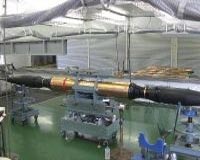| . |  |
. |
Livermore CA (SPX) May 11, 2010 Just a few years ago, Dan Farber happened to be doing field work in Peru with students when the 8.0 Pisco earthquake struck. As a scientist working in the active tectonics of the Peruvian Andes - funded through the Lawrence Livermore National Laboratory's Institute for Geophysics and Planetary Physics - Farber was asked by colleagues if he could participate in a rapid response team to map the damage of the seismic deformation and install a system of geodetic stations. He jumped at the opportunity to install a Global Positioning System (GPS) network to capture the post-seismic response and collected critical geological data for the understanding of the inter-plate dynamics of one of the Earth's largest subduction zones - the Central Peru Megathrust. In a new paper appearing in the journal Nature, Farber and international colleagues determined that the seismic slip on the Central Peru Megathrust is not dependent on earthquakes alone. As it turns out, movement along this subduction zone is caused by earthquakes as well as non-seismic (aseismic) related slip from steady or transient creep between or directly after earthquakes. "Active faults are made up of areas that slip mostly during earthquakes and areas that mostly slip aseismically," Farber said. "The size, location and frequency of earthquakes that a megathrust can generate depend on where and when aseismic creep is taking place." The 8.0 Pisco earthquake that occurred in 2007 ruptured the subduction interface - where load-bearing flat surfaces butt up - between the Nazca plate and the South American plate, an area that subducts about 6 centimeters per year. In this event, two distinct areas moved 60 seconds apart in a zone that had remained locked in between earthquakes. The event also triggered aseismic frictional afterslip on two adjacent areas. The most prominent afterslip coincides with the Nazca ridge subduction, which seems to have repeatedly acted as a barrier to seismic rupture propagation in the past. To sum up, aseismic (non-earthquake producing) slip accounts for as much as 50 percent to 70 percent of the slip on this portion of the megathrust in central Peru. Because much of the interface displacement is taken up aseismically, an earthquake the size of the 2007 earthquake is estimated to occur only every 250 years.
Share This Article With Planet Earth
Related Links Lawrence Livermore National Laboratory Tectonic Science and News
 USGS to upgrade quake monitoring networks
USGS to upgrade quake monitoring networksReston, Va. (UPI) Apr 20, 2010 The U.S. Geological Survey says it has awarded $2.7 million to four organizations to improve monitoring of the Earth's crust in earthquake-prone areas. The awards, made under the American Recovery and Reinvestment Act, went to the University of California-Berkeley, Central Washington University, the University of California-San Diego and UNAVCO Inc. to improve networks that detect minut ... read more |
|
| The content herein, unless otherwise known to be public domain, are Copyright 1995-2010 - SpaceDaily. AFP and UPI Wire Stories are copyright Agence France-Presse and United Press International. ESA Portal Reports are copyright European Space Agency. All NASA sourced material is public domain. Additional copyrights may apply in whole or part to other bona fide parties. Advertising does not imply endorsement,agreement or approval of any opinions, statements or information provided by SpaceDaily on any Web page published or hosted by SpaceDaily. Privacy Statement |